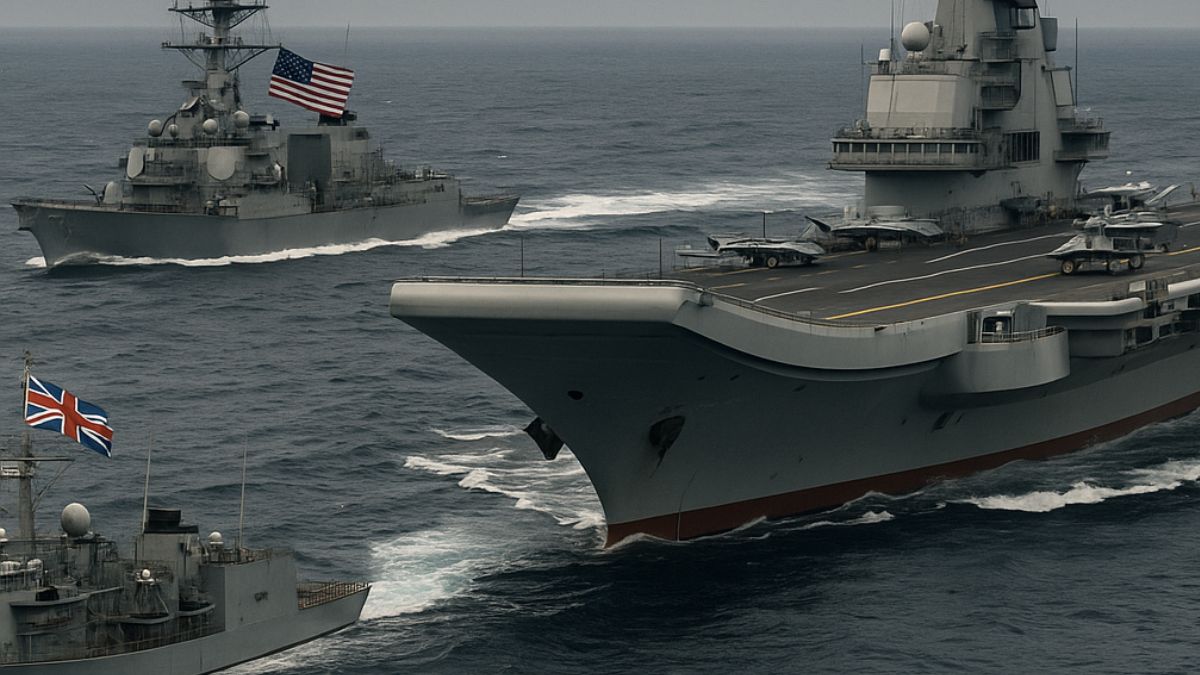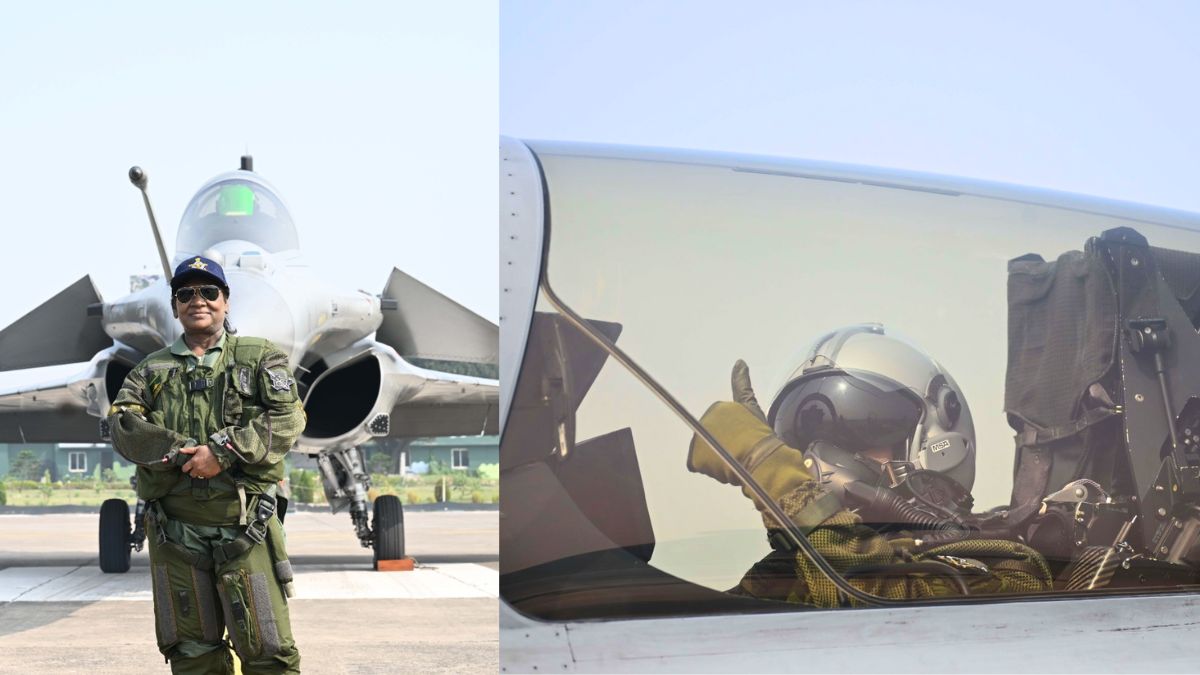China Slams US, UK Warships In Taiwan Strait As Fujian Carrier Sails South Amid Rising Regional Tensions

As China’s carrier Fujian sails south and US, UK warships cross the Taiwan Strait, Beijing clashes with Washington in military talks, Taiwan warns of a domino effect, and tensions spill into the South China Sea. Image courtesy: AI generatd picture via DALL-E
China has sharply accused the United States and Britain of destabilising the Taiwan Strait after their warships transited the contested waterway, an event the two allies characterised as a routine naval passage.
The latest tensions arise as Beijing advances its own naval manoeuvres, including the high-profile sailing of its newest and most advanced aircraft carrier, the Fujian, and amid growing friction with multiple regional players over the South China Sea.
On September 12, 2025, the People’s Liberation Army (PLA) Eastern Theatre Command announced that its naval and air forces closely tracked the US destroyer USS Higgins and the British frigate HMS Richmond during their transit.
Spokesman Senior Colonel Shi Yi condemned the move as “harassment and provocation,” alleging that it “sent wrong signals and undermined peace and stability in the Taiwan Strait.” Shi asserted that the command “remains on high alert” and would continue to safeguard what Beijing considers its national sovereignty.
The United States, Britain, and other allies such as Canada and Australia argue that the strait is an international waterway through which they conduct regular freedom-of-navigation operations. Just last week, a Canadian frigate and an Australian guided-missile destroyer also crossed the Taiwan Strait, prompting a similarly harsh response from Beijing.
Adding to the friction, the Fujian, China’s third and most sophisticated aircraft carrier, was spotted moving south through the strait after departing its Shanghai shipyard earlier this week.
Chinese officials said the ship was bound for scientific research and training in the South China Sea. The foreign ministry insisted the deployment was part of a “regular arrangement” in the vessel’s construction process, not directed at any particular target. Yet, once commissioned, the Fujian is expected to significantly enhance China’s ability to project power across the Western Pacific.
How has this development led to the US-China war of words?
The naval manoeuvres coincided with a tense exchange between Chinese Defence Minister Dong Jun and US Defence Secretary Pete Hegseth. In their first direct talks, Dong warned Washington against any attempt to support “Taiwan independence” or use the Taiwan issue to contain China. He declared that any such effort would be “thwarted.”
The Pentagon’s account of the call painted a different picture, noting that Hegseth emphasised the US does not seek conflict with China or regime change in Beijing. However, he reaffirmed that the Asia-Pacific remains a “priority theatre” where Washington has vital interests that it “will resolutely protect.”
Beijing considers Taiwan an inseparable part of China and has never ruled out the use of force to achieve reunification. While the United States does not recognise Taiwan as an independent state, it is legally committed to supplying Taipei with defensive arms and opposes any attempt to change the island’s status by force.
Why did Taiwan warn of a domino effect?
Against this backdrop, Taiwan’s Mainland Affairs Council chief Chiu Chui-cheng issued a stark warning in Washington. Speaking at the Heritage Foundation, he said China “has been actively preparing for war” and argued that Taiwan’s fall would trigger a “domino effect” that could threaten US security and undermine the regional balance of power.
Chiu stressed that China’s ruling Communist Party sees unification not just as a territorial issue but as a step toward sidelining US influence in the Indo-Pacific and achieving the so-called “China Dream” of restored national glory. He further highlighted Taiwan’s central role in global technology supply chains, especially as the leading producer of advanced semiconductors.
“If Taiwan’s role were compromised, it would be a huge loss to the international community, especially the US technology industry,” Chiu cautioned.
How has it led to escalation in the South China Sea?
Even as Taiwan tensions mount, Beijing has opened another front by approving a national nature reserve at Scarborough Shoal, a disputed reef claimed by the Philippines. Manila has strongly protested, calling the move “illegitimate and unlawful.” The shoal lies within the Philippines’ exclusive economic zone but has been under effective Chinese control since 2012.
China insists the reserve is aimed at protecting fragile marine ecosystems, but Philippine officials dismissed it as a political manoeuvre designed to entrench Beijing’s sovereignty claims. The shoal has long been a flashpoint, and analysts warn that the dispute could draw in the United States due to its mutual defence treaty with Manila.
How are strategic stakes rising?
The convergence of US-UK naval passages, China’s deployment of the Fujian, warnings from Taipei, and Beijing’s South China Sea manoeuvres underscores how maritime competition in Asia is intensifying. What Washington frames as routine navigation operations, Beijing interprets as foreign interference. Meanwhile, Taiwan’s leadership sees China’s growing military presence as preparation for eventual conflict.
As China broadens its activities from the Taiwan Strait to the South China Sea, the risk of miscalculation grows. For Washington and its allies, the challenge lies in balancing deterrence and reassurance, keeping the waters open without triggering escalation. For Beijing, the mission remains asserting sovereignty while navigating the costs of confrontation with an increasingly coordinated coalition of democracies.







